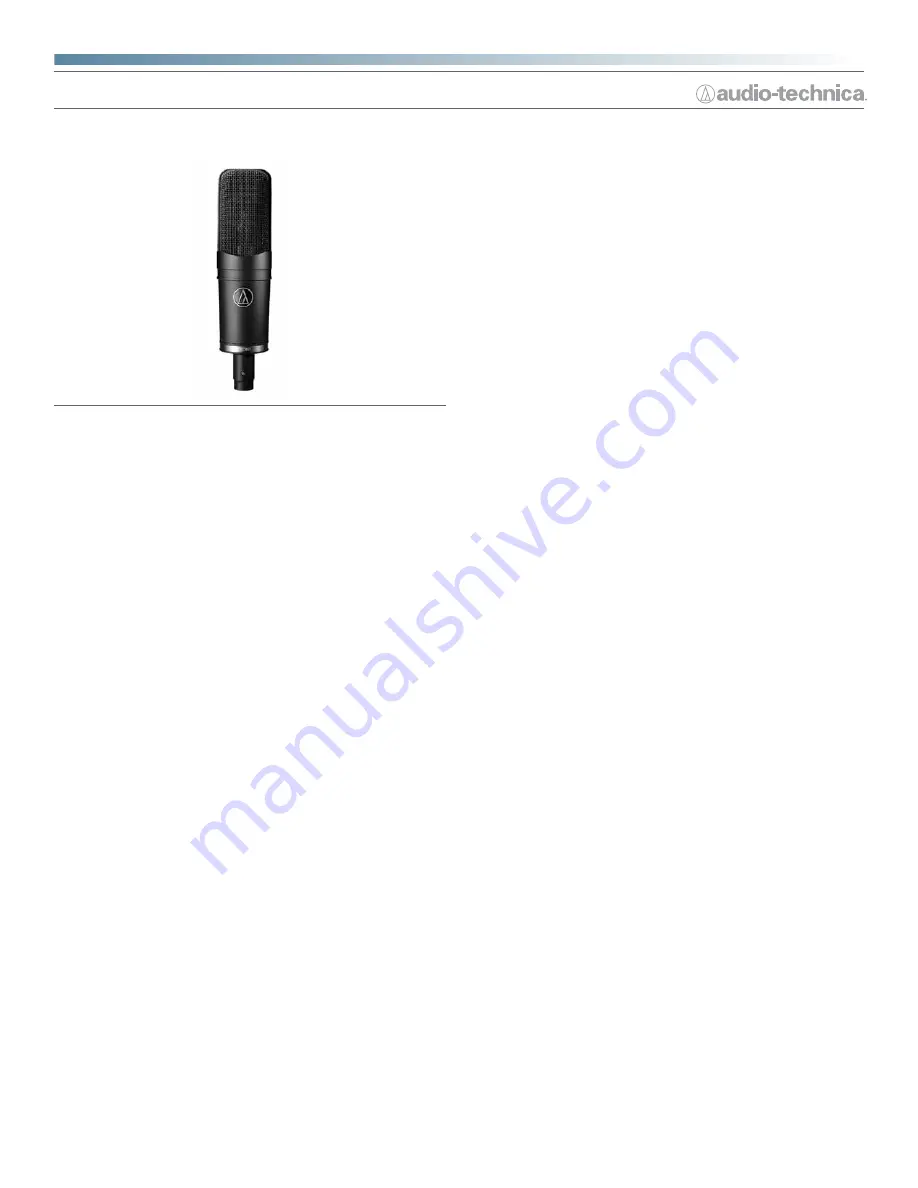
40 series
studio microphones
AT4060
Cardioid Vacuum Tube Condenser Side-Address Microphone
Features
• Vintage tube sound with the versatile performance necessary for
the most demanding studio applications
• Hand-selected tubes are individually tested and aged to maintain
peak performance
• Regulated and heavily filtered heater current prevents noise
contamination of audio signal chain
• Wide dynamic range, low self-noise and high max SPL capability
• Large coupling transformer provides superior low-frequency
linearity
• Dual-diaphragm capsule design maintains precise polar pattern
definition across the full frequency range of the microphone
• The 2-micron-thick, vapor-deposited gold diaphragms undergo a
five-step aging process so that the optimum characteristics
achieved remain constant over years of use
• Precision-machined, nickel-plated brass, acoustic element baffle
provides enhanced element stability and optimal sensitivity
• Custom shock mount provides superior isolation
Description
The AT4060 is a large-diaphragm side-address vacuum tube condenser
microphone with a cardioid polar pattern. It is designed for use in the
most demanding studio applications.
Each hand-selected tube is individually aged and tested, then employed
in a uniquely configured circuit for enhanced tube performance. Specially
tuned elements improve dynamic range and the ability to handle high SPLs
without sacrificing high-frequency characteristics. Floating-construction
mounting of the elements provides isolation from noise and vibration.
The microphone operates in conjunction with the included power supply,
which has low-impedance output and a ground-lift switch.
The cardioid polar pattern of the microphone is more sensitive to sound
originating directly in front of the element, making it useful in controlling
feedback, reducing pickup of unwanted sounds and providing isolation
between performers.
The microphone includes a 10 m (32.8') output cable terminating in 6-pin
XLR-type connectors for use between microphone and power supply.
The microphone is enclosed in a rugged housing. The included AT8447
shock mount provides superior isolation and permits mounting on any
microphone stand with
5
/
8
"-27 threads. A power supply, an AC power
cable, rack-mount adapters for power supply and a protective carrying
case are also included.
Operation & Maintenance
The AT4060 does not require phantom power but operates in conjunction
with the included power supply. The power supply has low-impedance
balanced output (3-pin XLRM-type connector) and a ground-lift switch,
which allows removal of hum caused by ground loops. The signal appears
across Pins 2 and 3; Pin 1 is ground (shield). Output phase is “Pin 2
hot”— positive acoustic pressure produces positive voltage at Pin 2.
To avoid phase cancellation and poor sound, all mic cables must be wired
consistently: Pin 1-to-Pin 1, etc.
The microphone includes an AT8447 shock mount to provide mechanical
isolation and secure mounting. This effective shock mount fits
5
/
8
"-27
threaded stands. To use, slide the microphone into the shock mount
basket and tighten the thumb screw to secure the microphone.
To set up the microphone with the power supply:
1) Make certain the power supply is turned off.
2) Plug the included 6-pin cable (female connector) into the
microphone; then plug the other end of the cable (male connector)
into the power supply.
3) Connect the output of the power supply into your mixer or other
audio interface (using your 3-pin XLR-XLR cable — not included). Do
not turn on the phantom power.
4) Plug the included IEC power cord into an AC wall outlet.
5) Turn on the power supply.
Important: Always turn the power supply off when connecting or
disconnecting any cables.
As with any sophisticated vacuum tube equipment, the AT4060 requires
a period of warm-up time before use. Allow at least 15 minutes after
switching on the power supply for the unit’s electronics to stabilize.
A raised Audio-Technica emblem is on the front of the microphone.
Position this side of the microphone toward the sound source.
In use, secure the cable to the mic stand or boom, leaving a slack loop
at the mic. This will ensure the most effective shock isolation and reduce
the possibility of accidentally pulling the microphone out of its mount.
Avoid leaving the microphone in the open sun or in areas where
temperatures exceed 110° F (43° C) for extended periods. Extremely high
humidity should also be avoided.
Architect’s and Engineer’s Specifications
The microphone shall be a side-address vacuum tube condenser. It shall
have a cardioid polar pattern with a uniform 120° angle of acceptance
and a frequency response of 20 Hz to 20,000 Hz. The microphone shall
operate from an external power supply (included) capable of operating
from 120V AC. It shall be capable of handling sound input levels up to 150
dB with a dynamic range of 131 dB. Nominal open-circuit output voltage
shall be 19.9 mV at 1 V, 1 Pascal. Output shall be low impedance
balanced (200 ohms).
The output of the microphone shall be a 6-pin XLRM-type connector. A
10 m (32.8') cable with 6-pin XLR-type connectors shall be supplied for
connection between the microphone and the included power supply. The
output of the power supply shall be a 3-pin XLRM-type connector.
The microphone shall be 210.0 mm (8.27") long and have a maximum
body diameter of 53.4 mm (2.10"). Weight shall be 640 g (22.6 oz). The




















